Radio Systems 3003359 Remote Control Transmitter/Pet Trainer User Manual
Radio Systems Corp Remote Control Transmitter/Pet Trainer
User Manual
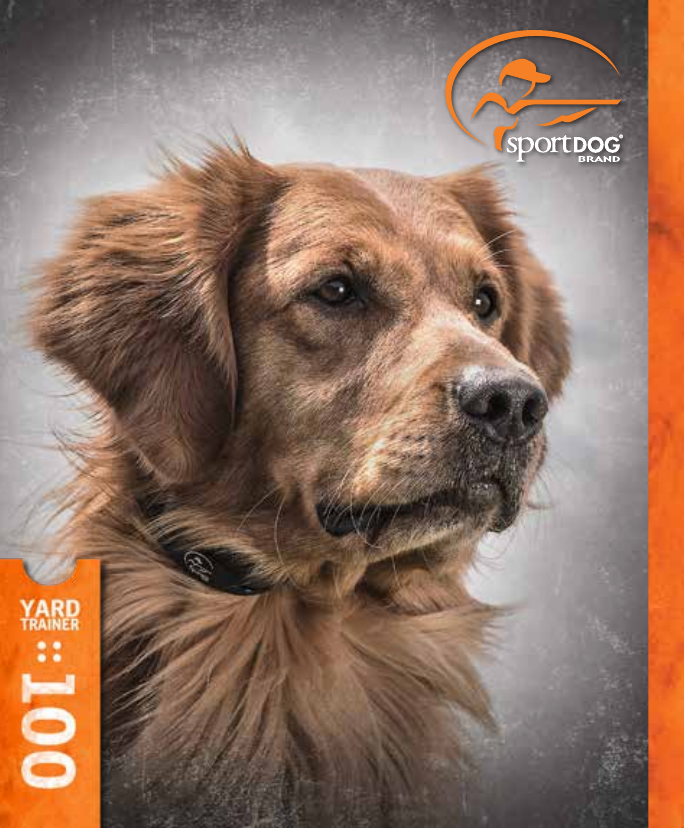
OPERATING AND BASIC TRAINING GUIDE
PLEASE READ THIS ENTIRE GUIDE BEFORE BEGINNING
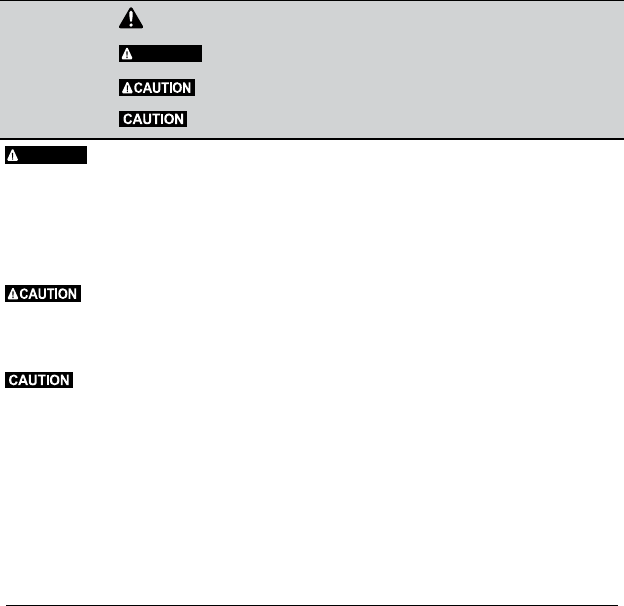
Thank you for choosing SportDOG Brand® training products. Used properly, this product will help you train your dog efficiently and
safely. To ensure your satisfaction, please review your Operating Guide thoroughly.
Hereinafter Radio Systems Corporation, Radio Systems PetSafe Europe Ltd., Radio Systems Australia Pty Ltd. and any other affiliate
or Brand of Radio Systems Corporation may be referred to collectively as “We” or “Us”.
IMPORTANT
SAFETY
INFORMATION
EXPLANATION OF
ATTENTION WORDS
AND SYMBOLS USED
IN THIS GUIDE
WARNING
• Do not use this product if your dog is prone to aggressive behaviour. Aggressive dogs can cause severe injury and even death to
their owner and others. If you are unsure whether this product is appropriate for your dog, please consult your veterinarian or a
certified trainer.
• This device contains Lithium-Ion (Li-Ion) batteries; never incinerate, puncture, deform, short-circuit, or charge with an
inappropriate charger. Fire, explosion, property damage, or bodily harm can occur if this warning is not followed.
• There is a risk of explosion if a battery is replaced by an incorrect type. Do not short circuit, mix old and new batteries, dispose of
in fire, or expose to water. When batteries are stored or disposed, they must be protected from shorting. Dispose of used batteries
properly.
It is vitally important that you and your dog remain safe while learning during on-leash/lead training. Your dog should be on a strong
leash/lead, long enough for him to attempt to chase an object, but short enough for him not to reach a road or other hazard. You must
be physically strong enough to restrain your dog if he tries to chase something.
This product is not a toy. Keep it out of the reach of children.
This is the safety alert symbol. It is used to alert you to potential personal injury hazards.
Obey all safety messages that follow this symbol to avoid possible injury or death.
WARNING
WARNING indicates a hazardous situation which, if not avoided, could result in death or
serious injury.
CAUTION, used with the safety alert symbol, indicates a hazardous situation which, if
not avoided, could result in minor or moderate injury.
CAUTION, used without the safety alert symbol, indicates a hazardous
situation which, if not avoided, could result in hard to your dog.
• Proper fit of the collar is important. A collar worn for too
long or made too tight on the dog’s neck may cause skin
damage ranging from redness to pressure ulcers. This
condition is commonly known as bed sores.
• Avoid leaving the collar on a dog for more than 12 hours
per day.
• When possible, reposition the collar on the dog’s neck every
1 to 2 hours.
• Regularly recheck the fit to prevent excessive pressure;
follow the instructions in this guide.
• You may need to trim the hair in the area of the Contact
Points. However, never shave the dog’s neck; this may lead
to a rash or infection.
• Never connect a leash/lead to a collar with Contact Points.
It will cause excessive pressure on the Contact Points.
• When connecting a leash/lead to a separate collar, do not
allow it to put pressure on the Collar Receiver.
• Wash the dog’s neck area and the Contact Points of the
collar weekly with a damp cloth.
• Examine the contact area daily for signs of a rash or a sore.
• If a rash or sore is found, discontinue using this product
until the skin has healed.
• If the condition persists beyond 48 hours, see your
veterinarian.
• For additional information on bed sores and pressure
necrosis, please visit sportdog.com.
• This product is only for use with healthy dogs. If you’re
not certain that your dog is in good health, we recommend
that you take your dog to a veterinarian before using this
product.
TERMS OF USE AND LIMITATION OF LIABILITY
1. TERMS OF USE: The use of this product is subject to your acceptance without modification of the terms, conditions, and notices
contained with this product. Use of this product implies acceptance of all such terms, conditions, and notices. If you do not wish
to accept these terms, conditions, and notices, please return the Product, unused, in its original packaging and at your own cost
and risk to the relevant Customer Care location together with proof of purchase for a full refund.

TERMS OF USE AND LIMITATION OF LIABILITY (CONT.)
2. PROPER USE: Proper Use includes, without limitation, reviewing the entire Operating Guide and any specific safety information
statements. The specific temperament or size/weight of your dog may not be suitable for this product. If you are unsure
whether this Product is appropriate for your dog, please consult your veterinarian or certified trainer prior to use. For products
used with dogs where training is desired, Radio Systems Corporation recommends that these training products are not used if
your dog is aggressive and accepts no liability for determining suitability in individual cases.
3. NO UNLAWFUL OR PROHIBITED USE: This product is designed for use with dogs only. This product is not intended to harm,
injure, or provoke. Using this product in a way that is not intended could result in violation of Federal, State, or local laws.
4. LIMITATION OF LIABILITY: In no event shall Radio Systems Corporation or any of its associated companies be liable for (i) any
direct, indirect, punitive, incidental, special or consequential damage and/or (ii) any loss or damages whatsoever arising out of
or connected with the use or misuse of this product. The Purchaser assumes all risks and liability from the use of this product
to the fullest extent permissible by law.
5. MODIFICATION OF TERMS AND CONDITIONS: Radio Systems Corporation reserves the right to change the terms, conditions,
and notices governing this product from time to time. If such changes have been notified to you prior to your use of this product,
they shall be binding on you as if incorporated herein.
FCC: USA
This device complies with part 15 of the FCC Rules. Operation is subject to the following two conditions: (1) This device may not cause
harmful interference, and (2) this device must accept any interference received, including interference that may cause undesired
operation.
NOTE: This equipment has been tested and found to comply with the limits for a Class B digital device, pursuant to part 15 of the FCC
Rules. These limits are designed to provide reasonable protection against harmful interference in a residential installation. This
equipment generates, uses, and can radiate radio frequency energy and, if not installed and used in accordance with the instructions,
may cause harmful interference to radio communications. However, there is no guarantee that interference will not occur in a
specific installation. If interference does occur to radio or television reception, which can be determined by turning the equipment off
and on, the user is encouraged to try to correct the interference by one or more of the following measures:
•Reorient or relocate the receiving antenna.
• Increase the separation between the equipment and the receiver.
• Connect the equipment to an outlet on a circuit different from that to which the receiver is connected.
• Consult Customer Care, the dealer, or an experienced radio/TV technician for help.
CAUTION: Modification or changes to this equipment not expressly approved by Radio Systems Corporation may void the user’s
authority to operate the equipment.
IMPORTANT RECYCLING ADVICE
Please respect the Waste Electrical and Electronic Equipment regulations in your country.
This equipment must be recycled. At the end of the product life, do not place it in the normal municipal waste system. Please check
the regulations in your area or return it to where it was purchased so that it can be placed in our recycling system. If these options are
not possible, please contact the Customer Care Center for further information.
©2018 RADIO SYSTEMS CORPORATION
Radio Systems Corporation • 10427 PetSafe Way • Knoxville, TN 37932 • 1.800.732.0144
SPORTDOG.COM
400-2249
IC: Canada
This device complies with Industry Canada license-exempt RSS standard(s). Operation is subject to the following two conditions:
(1) this device may not cause interference, and (2) this device must accept any interference, including interference that may cause
undesired operation of the device.
Le présent appareil est conforme aux CNR d’Industrie Canada applicables aux appareils radio exempts de licence.
L’exploitation est autorisée aux deux conditions suivantes : (1) l’appareil ne doit pas produire de brouillage, et (2)
l’utilisateur de l’appareil doit accepter tout brouillage radioélectrique subi, même si le brouillage est susceptible d’en
compromettre le fonctionnement.

21.800.732.0144
Thank you for choosing SportDOG Brand® training products. Used properly, this product will help
you train your dog efficiently and safely. To ensure your satisfaction, please review this owner’s
manual thoroughly. If you have questions regarding this product’s operation, please see this
manual’s Frequently Asked Questions or Troubleshooting sections, contact our Customer Care
Center at 1-800-732-0144, visit our website at www.sportdog.com, or view our support videos at
www.youtube.com/sportdogbrand.
To get the most protection out of your One Year Warranty, please register your product within 30
days at www.sportdog.com. By registering and keeping your receipt you will enjoy the product’s full
warranty and, should you ever need to call the Customer Care Center, we will be able to help you
faster. Most importantly, your valuable information will never be given or sold to anyone. Complete
warranty information is available online at www.sportdog.com.
TABLE OF CONTENTS
COMPONENTS ......................................................................................................................................3
HOW THE SYSTEM WORKS ...................................................................................................................3
ACCESSORIES .......................................................................................................................................3
KEY DEFINITIONS .................................................................................................................................4
PREPARE THE REMOTE TRANSMITTER ................................................................................................5
PREPARE THE COLLAR RECEIVER .........................................................................................................6
FIT THE COLLAR RECEIVER...................................................................................................................8
FIND THE BEST INTENSITY LEVEL FOR YOUR DOG ...............................................................................8
MATCH THE COLLAR RECEIVER AND REMOTE TRANSMITTER .............................................................9
BASIC TRAINING WITH PRO TRAINER CHARLIE JURNEY ....................................................................10
FREQUENTLY ASKED QUESTIONS .......................................................................................................18
TROUBLESHOOTING ...........................................................................................................................19
TEST LIGHT INSTRUCTIONS ...............................................................................................................19
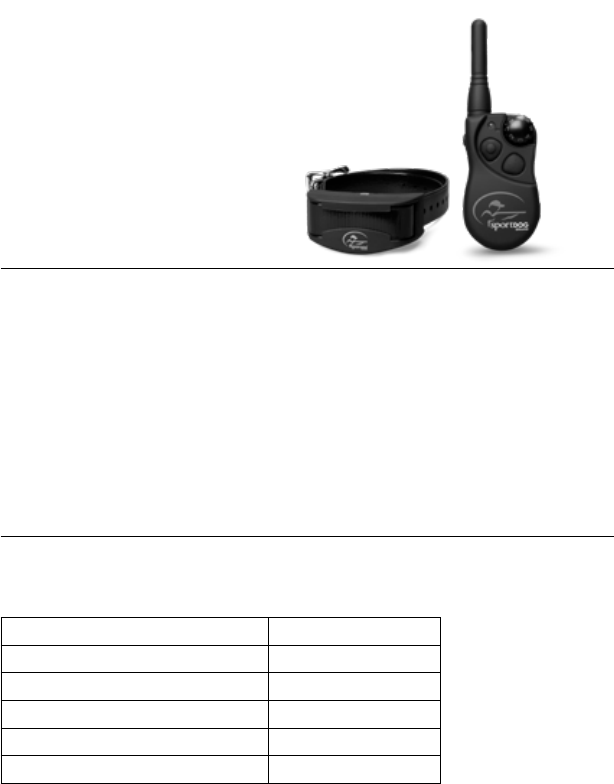
3SPORTDOG.COM
COMPONENTS
THE YARDTRAINER 100 & 100S CONTAIN:
• Remote Transmitter
• Collar Receiver
• Charge Cable
• Long Contact Points
• Lanyard
• Test Light Tool
HOW THE SYSTEM WORKS
The SportDOG Brand® YardTrainer 100 & 100S have been proven safe, comfortable, and effective for dogs
over 8 pounds. Consistent, correct use of this product allows you to reinforce commands and correct
misbehavior from up to 100 yards. The Remote Transmitter sends a signal, activating the Collar Receiver
to deliver a harmless stimulation. With proper training, a dog will learn to associate this signal with a
command. Like all SportDOG Brand products, this model features adjustable static stimulation levels so
you can tailor the stimulation level to your dog’s temperament, eliminating the risk of over-correction.
IMPORTANT: THE YARDTRAINER 100 & 100S HAVE A RANGE UP TO 100 YARDS. DEPENDING ON THE
WAY YOU HOLD THE REMOTE TRANSMITTER, THE MAXIMUM RANGE MAY VARY. FOR CONSISTENT
RESULTS AT LONGER RANGES, HOLD THE REMOTE TRANSMITTER IN A VERTICAL POSITION AWAY
FROM YOUR BODY AND OVER YOUR HEAD. TERRAIN, WEATHER, VEGETATION, TRANSMISSION FROM
OTHER RADIO DEVICES, AND OTHER FACTORS WILL AFFECT THE MAXIMUM RANGE.
ACCESSORIES
To purchase additional accessories for your SportDOG Brand® YardTrainer, contact the Customer Care
Center at 1-800-732-0144.
Component Part Number
Remote Transmitter
Collar Receiver
Charge Cable
Remote Transmitter Battery Kit
Collar Receiver Battery Kit
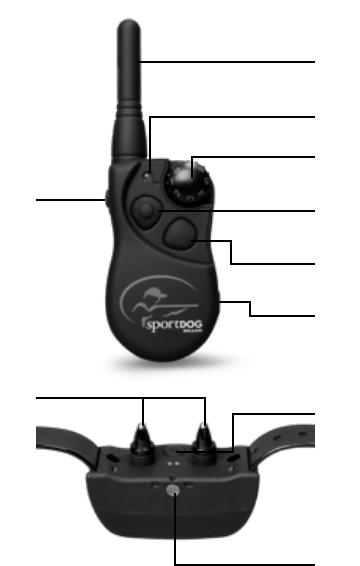
41.800.732.0144
KEY DEFINITIONS
REMOTE TRANSMITTER: Transmits the radio signal
to the Collar Receiver. It is waterproof and can be
submerged in water to a depth of 25 feet.
INTENSITY DIAL: Provides multiple levels of static
stimulation so you can match the correction to your dog’s
temperament.
TRANSMITTER INDICATOR LIGHT: Indicates that a
button is pressed and also serves as a low battery
indicator.
UPPER BUTTON: This button is factory-set to deliver
continuous static stimulation.
LOWER BUTTON: This button is factory-set to deliver
vibration stimulation.
SIDE BUTTON: This button is factory-set to deliver a tone.
CHARGING JACK: For connecting the charger. Although
the Remote Transmitter is waterproof without it, keep
the cover in place when not charging to keep debris out
of the opening.
THE COLLAR RECEIVER IS CAPABLE OF DELIVERING THREE TYPES OF STIMULATION:
CONTINUOUS: You control both when and how long static stimulation is delivered, up to a maximum of 10 seconds.
After 10 seconds the stimulation will “time out” and the Transmitter button needs to be released and then pressed
again before additional stimulation can be delivered. Quickly pressing and releasing the Upper Button will give a
brief correction or “nick”.
TONE: The Collar Receiver will make a rapid beeping noise when a Tone button is pressed.
VIBRATION: The Collar Receiver will vibrate when a Vibration button is pressed, up to a maximum of 10 seconds.
COLLAR RECEIVER: Receives the radio signal from the
Remote Transmitter and delivers the static, vibration,
or tone stimulation for correcting or cueing your dog. It
is waterproof and can be submerged in water to a depth
of 25 feet.
RECEIVER INDICATOR LIGHT: Indicates when the Collar
Receiver has been turned on or off, serves as a low-
battery indicator, and also indicates when the continuous
stimulation button is pressed.
CONTACT POINTS: The contacts through which the
Collar Receiver delivers static stimulation.
ON/OFF BUTTON: Momentarily pressing and releasing
this button turns the Collar Receiver on and off.
TRANSMITTER
INDICATOR LIGHT
TRANSMITTER
ANTENNA
INTENSITY DIAL
UPPER
BUTTON
LOWER
BUTTON
CHARGING
JACK
ON/OFF
BUTTON
RECEIVER
INDICATOR LIGHT
SIDE
BUTTON
CONTACT POINTS
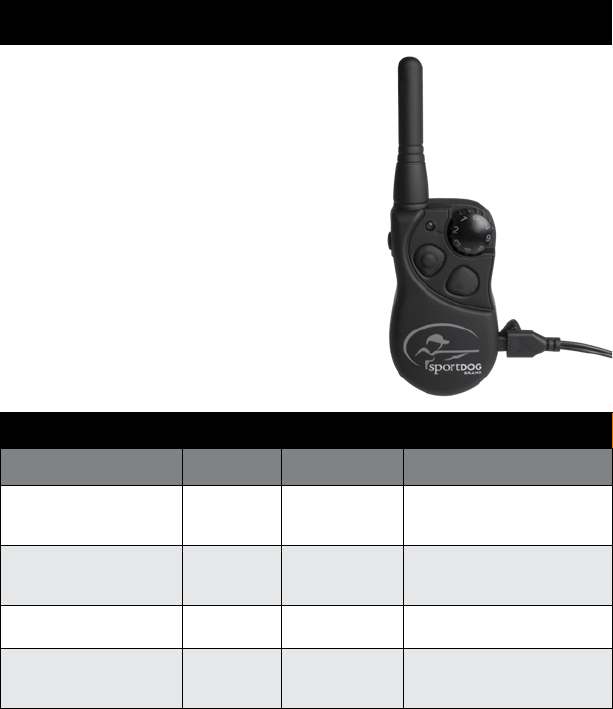
5SPORTDOG.COM
STEP::01
PREPARE THE REMOTE TRANSMITTER
CHARGE THE REMOTE TRANSMITTER
1. Lift the rubber cover protecting the Charging Jack.
2. Connect the corresponding charge connector to
the Charging Jack.
3. Plug the USB Adaptor into a power source.
4. Charge the Remote Transmitter for 2 hours for
the first charge and every charge thereafter.
Using Li-Ion technology, the Remote Transmitter
only requires a 2 hour charge. It is not harmful to
let the unit charge for more than 2 hours.
5. When charging is complete, replace the rubber cover.
NOTE: Approximate battery life between charges is
50 to 70 hours, depending on frequency of use.
TRANSMITTER INDICATOR LIGHT
OPERATIONAL MODE LIGHT COLOR BATTERY STATUS LIGHT FUNCTION
Continuous, tone, or
vibration stimulation button
pressed
Green Good Light is solid in color while button
is pressed
Continuous, tone, or
vibration stimulation button
pressed
Red Low Light is solid in color while button
is pressed
Unit is charging Green Low Light is solid in color while on the
charger
Unit is fully charged
(charger still connected)
Green Good Light flashes once per second
once the battery is completely
charged
CHARGE
CONNECTOR
PLACED IN
THE REMOTE
TRANSMITTER
CHARGING JACK
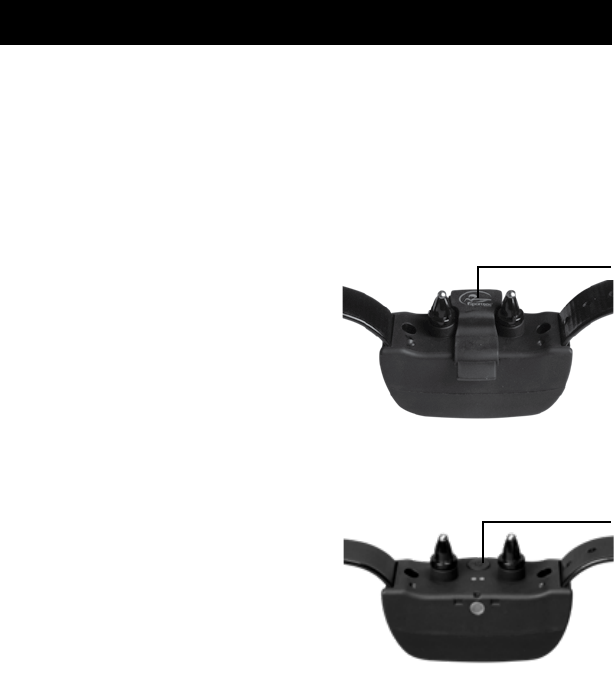
61.800.732.0144
STEP::02
PREPARE THE COLLAR RECEIVER
Before using the YardTrainer 100/100S for the first time, be sure to charge the unit by following the
steps described below.
The YardTrainer contains a rechargeable battery pack. When the unit indicates the battery in low (red
light indicator) it is time to recharge the unit. To conserve battery life, turn the YardTrainer 100/100S
off when not in use.
CHARGE THE COLLAR RECEIVER
1. Align the Charging Cradle with the Charging
Contacts as shown in the image. Push down on
the Charging Cradle until it snaps into place.
2. Plug the USB Adaptor into a power source. The
Indicator Light will be solid green while charging.
During charging, keep the YardTrainer 100/100S in
an open, well-ventilated area.
3. Charge the Collar Receiver for 2 hours for the first
charge and every charge thereafter. The Indicator
Light will flash green once charging is complete.
4. Remove the Charging Cradle from the YardTrainer
100/100S and unplug the USB Adaptor from the
power source.
Using Li-Ion technology, the Collar Receiver only
requires a 2 hour charge. It is not harmful to let the
unit charge for more than 2 hours.
TO TURN THE COLLAR RECEIVER ON
Press and release the On/Off Button, the Collar
Receiver Indicator Light will come on green or red,
depending on battery status.
TO TURN THE COLLAR RECEIVER OFF
Press and release the On/Off Button, the Receiver
Indicator Light comes on solid red and the Collar
Receiver beeps continuously for 2 seconds.
To extend the life between charging cycles, turn the Collar Receiver off when it is not in use.
NOTE: Approximate battery life between charges is 20-25 hours, depending on frequency of use.
ON/OFF
BUTTON
CHARGING CRADLE
PLACED ON THE
CHARGING CONTACTS
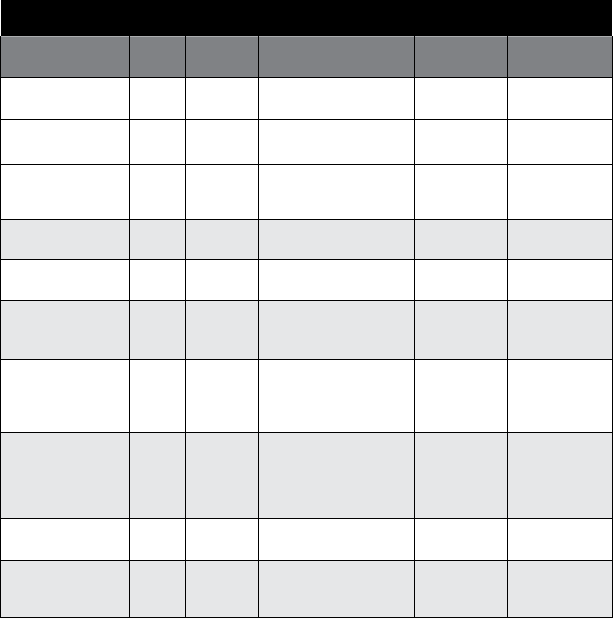
7SPORTDOG.COM
RECEIVER INDICATOR LIGHT
OPERATIONAL
MODE
LIGHT
COLOR
BATTERY
STATUS LIGHT FUNCTION SPEAKER
FUNCTION VIBRATION
Unit is turned on via
On/Off Button
Green Good Light is solid in color
during beep sequence
Unit will beep
once
N/A
Unit is turned on via
On/Off Button
Red Low Light is solid in color
during beep sequence
Unit will beep
once
Unit is turned off via
On/Off Button
Red N/A Light is solid in color
during beep sequence
Beeps
continuously
for 2seconds
N/A
Unit is on Green Good Light flashes every
2seconds
N/A N/A
Unit is on Red Low Light flashes every
2seconds
N/A N/A
Unit is delivering
continuous static
stimulation
Red N/A Light is solid in color
for as long as button is
pressed (up to 10seconds)
N/A N/A
Unit is delivering
tonestimulation
Off N/A N/A Unit will beep
for as long
as button is
pressed
N/A
Unit is delivering
vibration
stimulation
Off N/A N/A N/A Unit will vibrate
for as long
as button is
pressed (up to 10
seconds)
Unit is charging Green Low Light is solid in color
while charging
N/A N/A
Unit is fully
charged (charger
stillconnected)
Green Good Light flashes once per
second once the battery is
completely charged
N/A N/A
RECHARGEABLE BATTERIES
• Batteries should never be removed from the battery compartment for charging.
• Risk of explosion if batteries are charged in areas with high temperature (100° F+ / 38° C+).
• The rechargeable Lithium Ion (Li-Ion) batteries are not memory sensitive, do not require depletion
before charging, and cannot be over charged.
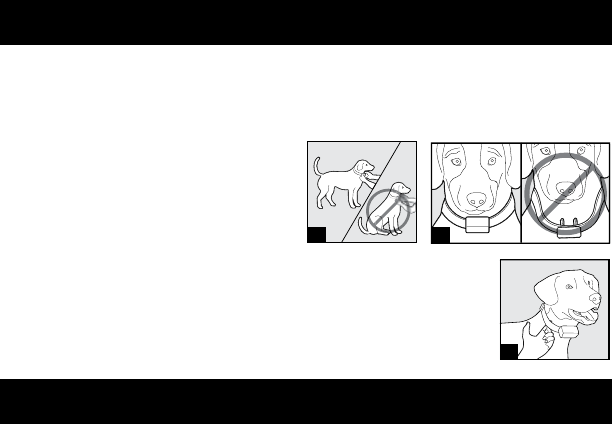
81.800.732.0144
• The batteries come partially charged from the factory, but will require a full charge before the first use.
• When storing the unit for long periods, remember to regularly give batteries a full charge. This
should be done once every 3 to 4 months.
• You should expect hundreds of recharge cycles from your batteries. However, all rechargeable
batteries lose capacity over time relative to the number of recharge cycles they experience. This is
normal. If your operating time drops to half of the original life, contact the Customer Care Center to
purchase a new battery.
• The batteries should last for a period of 3-5 years. When a battery needs replacement, you can order
a new pack by calling our Customer Care Center at 1-800-732-0144. Please do not open the Collar
Receiver or Remote Transmitter until you have received the replacement.
•
STEP::03
FIT THE COLLAR RECEIVER
IMPORTANT: The proper fit and placement of the Collar Receiver is important for effective training.
TheContact Points must have direct contact with your dog’s skin.
To ensure a proper fit, follow these steps:
1. With your dog standing (3A), center the Collar
Receiver so the Contact Points are underneath
your dog’s neck, touching the skin (3B). If your
dog has a long or thick coat, you have two
options to ensure consistent contact: either
trim the hair around the Contact Points or
switch to the longer Contact Points included with your system.
2. The Collar Receiver should fit snugly, yet loose enough to allow one finger to
fit between the strap and your dog’s neck (3C).
3. Allow your dog to wear the collar for several minutes, and then recheck the
fit. Check the fit again as your dog becomes more comfortable wearing the
Collar Receiver.
STEP::04
FIND THE BEST INTENSITY LEVEL FOR YOUR DOG
Your YardTrainer System has multiple intensity levels. This allows you to choose the static stimulation
that is best for your dog. For training efficiency, it is important to find the right intensity level for your
dog. This is called the Recognition Level, at which your dog looks around in curiosity, or flicks his ears.
NOTE: Always start at the lowest level and work your way up.
3A 3B
3C

9SPORTDOG.COM
FINDING YOUR DOG’S RECOGNITION LEVEL:
NOTE: Every dog is different and you cannot predict where your dog’s Recognition Level will be. Watch
closely for any slight change in behavior that demonstrates your dog is feeling the static stimulation.
1. With the Collar Receiver turned on and properly fitted to your dog, set the Remote Transmitter’s
Intensity Dial at Level 1 and press the Continuous Static Stimulation Button for 1 to 2 seconds.
2. If your dog shows no reaction to Level 1, go to Level 2 and repeat the process.
3. YOUR DOG SHOULD NOT VOCALIZE OR PANIC WHEN RECEIVING STATIC STIMULATION. IF THIS
HAPPENS, THE STATIC STIMULATION LEVEL IS TOO HIGH AND YOU NEED TO GO BACK TO THE
PREVIOUS LEVEL AND REPEAT THE PROCESS.
4. Once you find your dog’s Recognition Level, this is the level you should use when you begin a
training exercise.
5. If you have progressed to the highest static stimulation level while searching for your dog’s
Recognition Level and your dog continues to show no response, check to see if the Collar Receiver
is snug against your dog’s neck. Then go back to Intensity Level 1 and repeat the process. If your
dog still does not indicate he is feeling the static stimulation, you have two options: you may either
have to trim the hair beneath the Contact Points, or switch to the longer Contact Points included
in your system.
For more information on this topic see page 15. If after completing all of these steps your dog still
does not indicate he is feeling the static stimulation, please contact Customer Care Center
at 1-800-732-0144.
STEP::05
MATCH THE COLLAR RECEIVER AND REMOTE TRANSMITTER
To match the Collar Receiver to work with a new Remote Transmitter or to match a new Collar Receiver
to work with your existing Remote Transmitter:
1. Turn off the Collar Receiver.
2. Press and hold the On/Off Button. The Receiver Indicator Light will come on, then turn off after 4-5
seconds. If the On/Off Button is released too early, the Receiver Indicator Light will begin flashing as
normal. If this occurs, start over from 1.
3. After the Receiver Indicator Light has turned off, release the On/Off Button.
4. Press and hold the Upper Button on the Remote Transmitter until the Receiver Indicator Light flashes 5
times. Once the Receiver Indicator Light has flashed 5 times, the Collar Receiver has been matched and
will begin flashing as normal. If the Receiver Indicator Light does not flash 5 times, start over from 1.

10 1.800.732.0144
BASIC TRAINING
BEFORE TRAINING YOUR DOG WITH THIS PRODUCT
You will have the most success using this Remote Trainer if you always remember to teach a command
before trying to reinforce the command with a Remote Trainer. We recommend that you read the
following Basic Training instructions before training with this Remote Trainer. Your training will be
easier and proceed faster if you follow the guidelines in this teaching assistant
BASIC TRAINING WITH PRO TRAINER CHARLIE JURNEY
TRAINING YOUR DOG TO PERFORM OBEDIENCE COMMANDS ON A LEASH
It is mandatory that you control your dog’s actions during every training session. Initially, controlling
your dog during obedience training sessions is accomplished in two ways: 1) the leash and 2) the tone of
your voice. While on the leash, your dog does not have an opportunity to escape through the instinctive
mechanisms all canines possess. Bolting, biting, and quitting are no longer options. Your tone of voice
will later take the place of the leash. Later the e-collar will replace both and you will be able to put the
leash away until you train your next dog.
Your dog should always work for you because you are the most important relationship in its life, and
pleasing you should be at the top of its priority list. The positive reward any dog appreciates most from a
trainer is a thank you in the form of a loving shoulder stroke, affectionate eye contact, and a sincere “good
dog.” If your dog does not light up on any of those three, you need to reevaluate your relationship. Each
command should be followed with a positive reward of some fashion when your dog follows your lead.
THE FIRST COMMAND: NO
The first command your dog will learn is “No.” Usually your dog will understand this command by the
end of its first day with you. Your dog hears this command each time it is doing something wrong and it
comprehends the command by the way you say it. Your dog may have been running around the house
with your wife’s pantyhose in its mouth or chewing on your prized decoy when it hears that dreadful
word. Intonation expresses your feelings to your dog in a language that is universal. The tone of your
voice tells your dog that it is in trouble and through repetitive use, the word “No” comes to mean the
same thing. Voila! Our first conditioned response! (Thank you, Dr. Pavlov).
“No” means stop what you are doing immediately. Put yourself in your dog’s place when it hears this
command and understands it. The dog is thinking it must quickly stop what it is doing. Your dog would
gladly obey you, if it only knew what you desired. For this reason, when your dog does stop doing
whatever it was that bothered you, you must give another command expressing what will please you.
“No” is always followed with something that will make you happy. When you are happy, your dog will
see it through your eyes, feel it by your touch, and hear it in your tone. And, that is your dog’s positive
reward. Even when it makes a mistake and is corrected by the word “No,” it receives a reward by
following your next command. This is a simple and foolproof method.
11SPORTDOG.COM
THE MOST IMPORTANT COMMAND: HERE
“Here” is the most important command your dog will ever learn. It is an escape from almost any
trouble. “Here” tells your dog to come to you immediately and without deviation. This command is very
easy for your dog to learn if you will speak its language. Most dogs will make a beeline to any person
who kneels down and opens up their arms. In this position you are using postural language to welcome
your dog. While you are kneeling and your dog is running to you, add the verbal command “Here.”
Shower your dog with positive verbal rewards while stroking its shoulder.
Let’s take a second again and discuss how much positive reward to give a dog when it follows your
commands. Do you remember how your dog communicates to you that it understands and accepts your
actions? When your dog swallows, it says, “I understand.” So, back off the positive rewards when your
dog says it understands and accepts your thank you by swallowing. Continually stroking your dog’s
shoulder and praising it will eventually lessen the sincerity of your reward and that could be a huge
mistake. Training your dog to come to you with the “Here” command is done along with the postural
position of kneeling and opening up your arms.
The leash (or lead) should be used in training your dog on the command “Here” as soon as it is
comfortable with the leash. Give the command “Here” and apply a slight tug on the leash. Be sure to
release the leash pressure the instant the dog starts coming toward you. Many people try to maintain
leash pressure until the dog is at their side. While this works, it can be too much pressure and your dog
does not get the reward of turning the pressure off while it is coming to you. If your dog hesitates or
fails to come directly to you, give another tug with the lead and repeat “Here.” When your dog arrives
at your side, stroke its shoulder until it gives you a swallow response. Your dog has learned what you
want and now it is time to condition the response with repetition.
A POSITIONAL COMMAND: HEEL
“Heel” is a positional command that instructs your dog to assume a position beside your leg whether
you are walking, standing, running, or riding a horse. People seek professional help in teaching their
dog to heel properly more than for any other command. These folks always explain that their puppy
is a great dog but it will not walk on its leash. This means the dog feels like it is alpha and should lead
its owner where it pleases. Every dog will learn the proper heel position on its first day of training with
proper leash usage. Place the leash in its proper position behind your dog’s ears and begin walking
forward. If your dog attempts to lead you by moving ahead, simply change direction. The leash will
tighten around its neck and it will follow your new direction. It is imperative that no leash pressure
be present when your dog’s head is beside your knee. It will learn this position is safe and causes no
discomfort through repetition. Add the verbal command “Heel” after the dog assumes the correct
position and repeat “Heel” each time its head is beside your knee.
We have discussed how to correct your dog if it attempts to lead you, but what should you do if it tries
to lag behind or flop around like a fish instead of following your lead? Keep moving forward and allow
the leash to do its job. The important point is for you not to stop moving. If you stop walking to check
on your dog or coax it forward, the leash will relax and its pressure will stop. Your dog must learn that
the only way the pressure around its neck will disappear is by assuming the correct “Heel” position.
With repetition, this position will become a comfort zone.
12 1.800.732.0144
ANOTHER POSITIONAL COMMAND: SIT
The next command to teach is “Sit.” With this command, you tell your dog to sit and remain seated
until it receives another command. The leash applies pressure to the underside of the dog’s neck when
you are training it to sit. You are now working on a different pressure point. Pull straight up on the
lead with your right hand and push down on your dog’s butt with your left hand until its bottom hits
the ground. Add a verbal “Sit” and release the pressure on the leash. Pressure from the leash can be
omitted when your dog is consistently sitting on verbal commands. Later you will get into corrections
and the steps you should follow to make things clear for your dog. Repeat the “Sit” drill until your dog
is happily driving nails with its rear.
Have you ever seen a dog sit sideways? It flops down and comes to rest on one hip. This is a common
occurrence for lazy dogs and needs to be corrected. Pull up on the leash until your dog sits in a proper
fashion. It may become necessary to step forward if your dog will not align itself properly at first.
Fight for the proper sit position now and you won’t have to address this in the future when you are
asking it to sit in the face of overwhelming distractions.
Now your dog has learned to come to you, walk comfortably beside you, and sit on command. It must
concentrate and use its brain as it learns these skills. Pay close attention to your dog’s focus, making
sure that the training sessions are not too long. Even though your dog’s brain is a sponge at this point,
it can become oversaturated and unable to receive anymore constructive information.
A FOLLOWUP TO “SIT”: STAY
When you give your dog the “Sit” command, you’ve told it to sit and remain seated until it receives
another command. Many obedience programs no longer use the “Stay” command, believing it is
redundant and not necessary. However, it would be good for you to know how to condition for this
command if your dog struggles with remaining seated. To reinforce sitting, apply a light amount of
upward leash pressure to its collar and command “Stay” as you start to move away and toward the end
of the leash. Your dog will likely get up and try to move with you. If this occurs, stop it with “No,” reseat
the dog with “Sit,” and repeat “Stay” with another upward tug on the leash. It should not take too many
corrections before your dog figures this puzzle out. Should it continually refuse to stay, add increasing
amounts of leash pressure and stronger “No” commands until it obeys. You may need to be more patient
here than any other place. You have already conditioned your dog to move with you at heel as you
move away and many dogs think this is what you want now instead of remaining seated. Correction for
mistakes, rewards for positive responses, and repetition will quickly condition your dog to this command.
A DIRECTIONAL COMMAND: KENNEL
You will often require your dog to enter different areas and objects: airline crates, vehicles, buildings,
boats, duck blinds, and fenced areas are just a few examples. You will use the command “Kennel” to
tell your dog to enter what is in front of it. Always use the command “Sit” before you ask a dog to enter.
If you give your dog a chance to sit and look into the area it is being asked to enter, it will be far more
likely to perform this skill without a fight. By looking into this area, your dog can see that the boogie
man is not waiting inside.
13SPORTDOG.COM
What should you do if your dog decides it does not want to enter? You know it will give to the pressure of a
leash, so lead it into the proper area and command “Kennel.” Once in the correct place, stroke pup on the
shoulder until you see acceptance via the swallow response. Repeat this routine until you start to develop
a conditioned response to your command. Some dogs fight this entry with a great deal of vigor. If your
dog chooses this option, be sure to maintain leash pressure until you get the desired response. Once it
understands that there is no danger in these areas, it will be glad to enter upon command.
Think about your individual training situation and see if you can create opportunities to work on the
“Kennel” command. This can be accomplished by having an airline crate with you while doing your
dog’s obedience routine or working in an area close to the entrance of your home where the doorway
becomes the area in which your dog is commanded to enter. Or, you could use your vehicle, and this will
be very handy when you take your dog to other training areas.
A FINAL OBEDIENCE COMMAND: DOWN
The next command in your obedience program will be “Down,” which tells your dog to lie down and
remain in this position until it receives another command. This command is most often used around
the home. For this reason, the easiest time to work on “Down” is at night while watching television.
Command your dog to “Sit” and stroke its shoulder when it obeys. Face the dog, grab its front paws, and
pull them toward you. When your dog’s chest hits the floor, command “Down” and stroke a shoulder
again. Most dogs will immediately rise, assuming a sit position. If this occurs, correct your dog with
“No” and repeat the “Down” process again. It generally takes around three evenings before your dog
will become comfortable with this routine. But, do not be worried if it takes your dog three weeks.
UNDERSTANDING CORRECTION
We have spoken very little about correcting your dog for making a mistake up until this time. No dog
is perfect and many mistakes are going to occur while training. In reality you want your dog to make
mistakes so you can clearly show the difference between right and wrong. It is important that you
have a correction method that your dog understands and comfortably accepts. Here is the correction
system you should use from Day One. The same correction system will be used for the rest of your
dog’s life whether you are using a leash or e-collar to correct improper responses.
1. Give your dog a command. If it obeys, use a positive reward. If it fails to obey, proceed to Step 2.
2. Stop your dog’s incorrect action with the command “No.” Repeat the command after you get the
incorrect actions stopped. If your dog obeys, use a positive reward. If it fails to obey, proceed to Step 3.
3. Stop your dog’s incorrect action with the command “No” and use the physical pressure of your
leash until the correct response occurs. Immediately release the pressure when your dog obeys,
repeat the command, and praise with a positive reward.
If you are consistent in this correction process, the verbal correction of “No” will become much more
powerful. Your dog will learn through daily usage that if it does not follow your lead after the command
“No,” there will be some form of physical pressure (leash or electronic). Your dog does not like being
corrected any more than you do. Correction will be a part of its life and it will accept this correction as
long as you give it in a comfortable and systematic fashion. This means you must be consistent and you
cannot hurt your dog by hitting, kicking, or overstimulating when you become frustrated.
14 1.800.732.0144
APPLICATION OF THE ELECTRONIC COLLAR
E-collar use has come a long way. The equipment is better and the many available programs for
training with e-collars are better. Some people don’t believe e-collars are reliable enough and
therefore they shouldn’t be used, but successful results are dependent on the skills of the operator, not
the product. It is very rare for a dog to not accept and happily work while on a leash, but you can hurt
your dog’s attitude if it is used improperly. It is the same with e-collars. You can do an unbelievable
amount of damage to your dog’s attitude by over correcting with an e-collar if you do not know what
you are doing or if you don’t control your actions. This program will show you how to use an e-collar,
but you must never lose control of your emotions. So, make a promise to yourself and your dog that
you will always remain focused and in control when training.
In the beginning, e-collars were simple metal boxes with an on/off switch and no way to adjust the
static stimulation levels. And they were often unreliable. SportDOG Brand
®
remote training systems
are an example of how advanced e-training products have become. SportDOG Brand offers several
excellent models that work at great distances over land or in water.
THE RIGHT WAY TO BEGIN
Your dog needs to start wearing an e-collar as soon as it can comfortably support the collar’s weight.
The collar should be worn from that point forward during all training sessions. Initially, you should
attach the collar and do something fun such as retrieving exercises with a bumper or ball. Continue
this until your pup’s tail is wagging uncontrollably. Soon, your dog will be doing airplane spins each
time it sees the collar and think, “Oh boy, we are getting ready to have some fun!” That is a pretty nice
first impression. This is an important first step in collar conditioning: your dog’s acceptance of the
e-collar in a fun fashion.
You shouldn’t be pressing any of the Remote Transmitter’s buttons until your dog is 100 percent
reliable on obedience drills. When you have to deliver a correction you do not want your dog trying
to guess what you expect. Your dog should be performing these skills masterfully in the face of
distractions. If you did your homework, your dog will have an excellent understanding of what you
are asking while being able to process pressure at the same time. Before, pressure was in the form of
a leash. Now, it will be an electronic, brief correction from the collar. Your dog already knows what
to do in the face of pressure; you are simply changing the type of pressure. Previously the pressure of
the leash was on your dog’s neck and that is where the e-collar also applies pressure, but in a different
form. The e-collar will now become an infinitely long leash to your dog. A brief correction with the
collar will take the place of a tug on the lead. This sounds pretty simple doesn’t it? Keep it that simple
and you and your dog will be happy.
Always remember: You are not going to teach your dog anything with an e-collar. You are only adding
electronic pressure to a skill your dog already knows and can routinely perform. Also, do not use the
e-collar to correct responses in an area where your dog may have not performed these skills until the
training process is finished.
15SPORTDOG.COM
FINDING THE CORRECT STATIC STIMULATION LEVEL
The hardest thing about using an e-collar is finding the proper level of static stimulation and sticking
with it. Some folks are of the opinion that you should use continuous high-level static stimulation
until the dog complies. Others think you should use low-level continuous static stimulation. Both
programs can work and create a dog that performs great, but either of these methods could lead to
trouble for a novice trainer.
Your long-term goal is to have your dog remain under total control while receiving correction from
the e-collar and understand why the correction occurred. Remain under total control is the key
phrase in that sentence. If your dog is jumping around or cannot focus on you because it is vocalizing,
it is not under control. If your dog reacts in either of these ways, back off. Either you are progressing
too fast or the static stimulation intensity is too high.
You should shop for the correct level of static stimulation by starting with the lowest intensity
and continuing up until you see the acceptance mechanisms appear. This is first introduced during
obedience drills. With your dog on-leash, call it to you. After a few successful “Here” routines, apply
leash pressure and stimulate with the e-collar at the same time. Look for the swallow response,
head drop, or neck twitch. Sometimes you can see a change in the breathing pattern. Progress up in
intensity until you see your dog say, “I accept” with one of these responses. When you see your dog
drop its head or swallow, you are there and this will be your most-often used correction level.
COLLAR CONDITIONING WITHIN EACH OBEDIENCE COMMAND
Never correct your dog with the e-collar without first conditioning it to accept and understand the
collar. This will take a short period of time, but without the conditioning process, your dog will be
dazed and confused about the discomfort around its neck. It is easy to confuse your dog and undo
a couple of months of good training in just a few minutes by over-stimulating on a correction or
correcting when it is not justified. No corrections should occur until the conditioning process has been
successfully completed. The collar-conditioning process can be thought of as practice in accepting
electronic static stimulation. Your football coach didn’t send you on the field without practicing the
plays and likewise, we do not want to send your dog into the world without an understanding of how to
comfortably accept electronic correction.
16 1.800.732.0144
USING AN ECOLLAR TO REINFORCE OBEDIENCE COMMANDS
“HERE”
Bolting can become a disastrous side-effect of e-collar conditioning if your dog is allowed to move away
from your control. Therefore, keep using the leash until the conditioning process is finished. Toss a few
bumpers and work on obedience drills in the training area. Check for that wagging tail which signals
a good attitude. Then command “Here,” deliver a brief correction on the correct level – paying close
attention to the dog’s reaction – and then immediately command “Here” again. Reward your dog with a
stroke on the shoulder and verbal praise. Repeat “Here”-brief correction-“Here” three to five times on
the first day at various places in the work area while making sure that no two brief corrections occur at
the same spot. Your dog will receive at least three brief corrections, but no more than five, during the
first couple of sessions. If things are going well, you can go to five. But, if your dog is nervous, stop at
three. Continue the obedience routine with no static stimulation for a little longer. Make sure rewards
follow proper responses. Finish by throwing a bumper or ball to each spot where your dog received static
stimulation in an effort to show that the location had nothing to do with why the correction occurred.
Pay close attention to your dog’s attitude during this routine. If momentum fades, use fewer brief
corrections and more play time. Increase the reward by adding a few extra shoulder strokes along
with a happy tone of voice. Don’t be afraid to skip a day if your dog shows repeated signs of too much
pressure. This is not likely to occur if you are careful, but understand how to overcome it just in case.
“SIT”
Next, it is time to condition your dog to sit and accept a correction while maintaining control in the seated
position. Have your dog do a quick obedience drill and command “Sit.” While the dog is seated, give a brief
correction with the collar and immediately command “Sit” again. If it moves around or gets up, return the
dog to the seated position by using the leash. Reward on the shoulder and verbally. Repeat the “Sit”-brief
correction-“Sit” three to five times per session. As before, move around so you do not stimulate your dog
at any spot more than once. Use a positive reward after each successful brief correction.
“STAY”
When your dog is comfortably accepting e-collar pressure while remaining seated, you can start to use
the e-collar for correction on the “Stay” command. After successfully seating your dog, command “Stay,”
deliver a brief correction and command “Stay” again. Watch for the acceptance response and do not
move ahead until you get it. Call your dog to you and repeat the process several times without e-collar
stimulation. Repeat the “Stay”-brief correction-“Stay” at other locations and repeat this process until
your dog is the picture of perfection, remaining seated even when distractions tempt it to get up and move.
17SPORTDOG.COM
“HEEL”
Your dog learned to heel beside you earlier in the program, and transferring this command to e-collar
correction is simple. Walk your dog on-leash and change directions. As the leash tightens, command
“Heel,” give a brief correction with the collar and command “Heel” again. It is important to apply the
brief correction at the same time the leash is tight instead of when the dog is coming to you. Reward
with verbal praise and a stroke on the shoulder until you see the acceptance swallow. Repeat this
routine as you walk together in various locations until your dog is comfortable.
Your dog is now conditioned to accept the e-collar while coming, heeling, or sitting on command.
It is time to mix the commands into a full “Here”-“Heel”-“Sit” drill. Use your brief correction at
varying times as your dog allows and as before, avoid successive brief corrections or multiple brief
corrections in the same area. You can increase the number of brief corrections as long as you pay
close attention to your dog’s attitude. Toss a few bumpers to chase when necessary to relieve pressure
and pour on the positive rewards as needed.
“DOWN”
Your dog understands the “Down” command and can perform it without any trouble by now if you
did your homework. Now you can easily add the e-collar to this routine in the same fashion as
before. Place your dog in the “Down” position with a verbal command. Command “Down” again, give
a brief correction with the e-collar and repeat “Down.” Watch how your dog reacts, looking for the
acceptance signals. Praise with a stroke on the shoulder and verbally. As before, you need to condition
this with repetition.
KEEP THAT COLLAR ON!
At some time, you will get to a point where you feel like your dog no longer needs to wear the e-collar
because it never makes a mistake. Congratulations on a job well done! However, your dog should
always wear the e-collar when in environments that contain distractions. Would you drive your car
across the country without automobile liability insurance? You should now think of the e-collar as
your insurance policy in case you and your dog get into a wreck. It gives your dog a way out of trouble
in an orderly fashion that it understands even when its instincts are telling it to do something else.
What does it hurt for your dog to wear the e-collar when you go to the park, Grandma comes for a visit,
it is time to go to the vet, or a million other unknown distractions? You taught that the e-collar means
the two of you are getting ready to do something fun, so keep the e-collar on.
ENJOY THE TRIP
You have now learned how to start down the road to a life of enjoyment with your dog. Some of these
steps may need to be covered again if your dog has repeated failures. That is no problem as long as you
take it easy and enjoy the ride together. Arriving is one of our goals but the trip that takes you there
will be filled with memorable times that will cement you and your dog’s relationship forever.
GOOD TRAINING!
Charlie Jurney of Terrell, North Carolina, is a professional retriever trainer and owner of Beaverdam
Kennels, producer of Grand Master Hunting Retrievers and Master Hunting Retrievers. Most recently,
Charlie authored the Finished Dog retriever training book.

18 1.800.732.0144
FREQUENTLY ASKED QUESTIONS
Is the static stimulation safe for
my dog?
While the static stimulation is unpleasant, it is harmless to your
dog. Electronic training devices require interaction and training
from the owner to achieve desired results.
How old does a dog have to be before
using the YardTrainer 100/100S?
Your dog should be able to learn basic obedience commands such
as “Sit” or “Stay.” The Collar Receiver may be too large for dogs
under 8 pounds.
Once my dog is trained and has been
obeying my commands, will my dog
have to continue to wear the Collar
Receiver?
Your dog may need to wear the Collar Receiver from time to time for
reinforcement.
Is the Collar Receiver waterproof? Yes. If the rechargeable battery pack ever needs to be replaced, make
sure the o-ring and o-ring groove are free from dirt and debris.
Can I use the YardTrainer 100/100S on
aggressive dogs?
We do not recommend any of our products to be used on aggressive
dogs. We recommend you contact your local veterinarian or
professional trainer to determine if your dog might be aggressive.
Will I get exactly 100 yards of range with
the YardTrainer 100/100S?
The range you get with your YardTrainer 100/100S will vary
according to terrain, weather, vegetation as well as transmission
from other radio devices. To get the maximum amount of range,
please refer to “How the System Works” section of this guide.
How long can I continuously deliver
static stimulation to my dog?
The maximum amount of time you can press the Continuous
Static Stimulation Button and deliver static stimulation to your
dog continuously is 10 seconds. After 10 seconds, the Remote
Transmitter will “time-out,” and the Continuous Static Stimulation
Button must be released and pressed again.
What do I do if my dog’s neck becomes
red and irritated?
This condition is due to the Contact Points irritating the skin.
Discontinue use of the Collar Receiver for a few days. If the
condition persists beyond 48 hours, see your veterinarian. Once the
skin returns to normal, resume use, and monitor the skin condition
closely.
Can I use the YardTrainer 100/100S with
more than one dog?
No. The YardTrainer 100/100S is a 1-dog system.
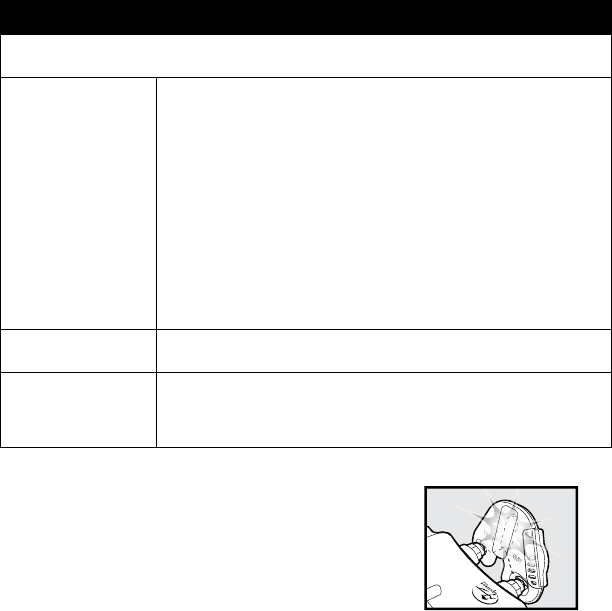
19SPORTDOG.COM
TROUBLESHOOTING
The answers to these questions should help you solve any problem you have with this system. If they do not,
please contact the Customer Care Center at 1-800-732-0144 or visit our website at www.sportdog.com.
My dog is not responding
when I press a button.
• Check to see if the Collar Receiver has been turned on and the Indicator Light
is flashing.
• If your range has reduced from the first time you have used it, your Remote
Transmitter or Collar Receiver battery may need to be replaced.
• Many factors can impact the range you have with the YardTrainer 100/100S. For a
list of these factors, please refer to “How the System Works.”
• You can verify the Collar Receiver is delivering static stimulation to your dog by
placing the test light, enclosed in your kit, on the Collar Receiver. Please refer to
the “Test Light Instructions” for details.
• Increase the Intensity Dial. Refer to “Find the Best Intensity Level For Your Dog” for
more information.
• Make sure the Collar Receiver’s Contact Points are placed snugly against your
dog’s skin. Refer to “Fit the Collar Receiver” for more information.
• You may need to switch to the longer Contact Points included with your system or
trim the hair beneath the Contact Points, never shave your dog’s neck.
The Collar Receiver will
not turn on.
• Try charging the Collar Receiver (see STEP 2).
The Collar Receiver is not
responding to the Remote
Transmitter.
• Verify the Collar Receiver has been turned on and the Indicator Light is flashing.
Refer to “Turning the Collar Receiver On and Off.”
• Refer to “Match the Collar Receiver and Remote Transmitter.”
• Try charging the Remote Transmitter (see STEP 1).
TEST LIGHT INSTRUCTIONS
1. Turn on the Collar Receiver.
2. Hold the Test Light Contacts to the Contact Points.
3. Press the Upper Button on the Remote Transmitter.
4. The Test Light will flash.
NOTE: At higher static stimulation levels, the Test Light will
flash brighter.
5. Turn off the Collar Receiver.
Save the Test Light for future testing.
NOTE: If the Test Light does not flash, recharge the battery and retest. If the Test Light still does not flash, contact the
Customer Care Center at 1-800-732-0144.
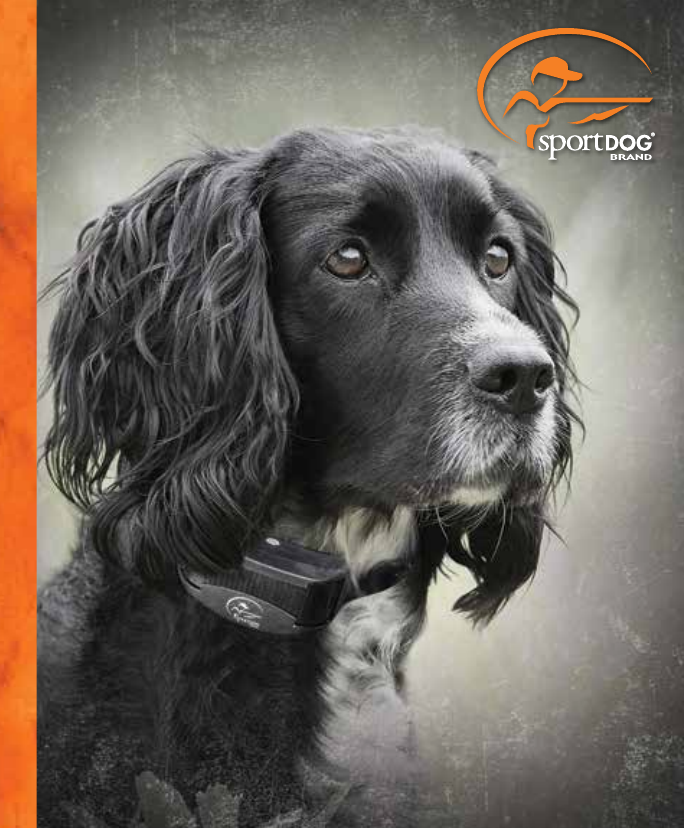
SPORTDOG.COM
©2018 RADIO SYSTEMS CORPORATION
Radio Systems Corporation • 10427 PetSafe Way • Knoxville, TN 37932 USA • 1.800.732.0144
400-2248